
Conversion (31)
Efficient C# Image to PDF Guide: Convert JPG/ PNG to PDF with Code Examples
2022-03-30 06:26:00 Written by KoohjiImages (JPG, PNG, BMP, etc.) are common for data capture, but PDFs provide better security, compression, and cross-platform consistency. In .NET development, developers may often need a reliable C# image to PDF solution to streamline workflows like report generation, document archiving, and digital record management.
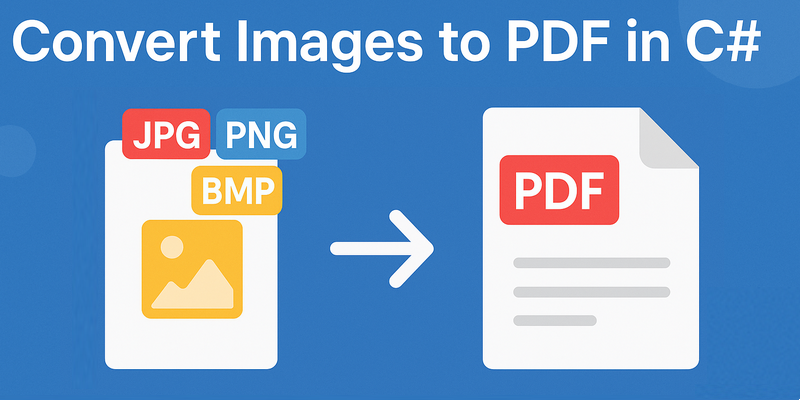
This guide demonstrates how to efficiently convert images to PDF in C#/ ASP.NET using Spire.PDF for .NET, a powerful library that simplifies this process with robust features and excellent compatibility.
- Set Up Your Project
- How to Convert Image to PDF in C#
- Image to PDF Customization Options
- FAQs (TIFF to PDF, SVG to PDF)
- Conclusion
Set Up Your Project
Before we start writing code to convert images such as PNG to PDF, we need to set up our C# project and add the Spire.PDF library.
Step 1: Create a New C# Project
Open Visual Studio and create a new C# project. You can choose a Console Application, Windows Forms Application, or any other project type depending on your needs.
Step 2: Install Spire.PDF
There are a few ways to add the PDF converter library to your project. One common method is through NuGet Package Manager.
- In Visual Studio, right-click on your project in the Solution Explorer, select "Manage NuGet Packages".
- In the NuGet Package Manager window, search for "Spire.PDF".
- Then, click "Install" to add the latest version of the library to your project.
Once the installation is complete, you'll be able to reference the necessary namespaces in your C# code.
How to Convert Image to PDF in C#
Spire.PDF does not provide a straightforward method to convert images to PDF. But you could create a new PDF document and draw images at the specified locations of a certain page. The following are two code examples for single/multiple image conversion.
Converting a Single Image to PDF
This example shows how to convert a JPG image to a PDF document, with the PDF page match the exact dimensions of the image.
C# code for JPG to PDF conversion:
using System.Drawing;
using Spire.Pdf;
using Spire.Pdf.Graphics;
namespace ConvertImageToPdf
{
class Program
{
static void Main(string[] args)
{
// Create a PdfDocument object
PdfDocument doc = new PdfDocument();
// Set the margins to 0
doc.PageSettings.SetMargins(0);
// Load an image
Image image = Image.FromFile(@"C:\Users\Administrator\Desktop\announcement.jpg");
// Get the image width and height
float width = image.PhysicalDimension.Width;
float height = image.PhysicalDimension.Height;
// Add a page of the same size as the image
PdfPageBase page = doc.Pages.Add(new SizeF(width, height));
// Load a JPG image and draw it at (0, 0) of the page
PdfImage pdfImage = PdfImage.FromImage(image);
page.Canvas.DrawImage(pdfImage, 0, 0, pdfImage.Width, pdfImage.Height);
// Save the PDF file
doc.SaveToFile("ConvertPdfWithSameSize.pdf");
}
}
}
Explanation:
- PdfDocument: Represents the PDF file.
- PdfPageBase: A page in the PDF document.
- PdfImage.FromImage: Converts an Image object to a PDF image.
- DrawImage: Renders the image on the PDF page.
Output:
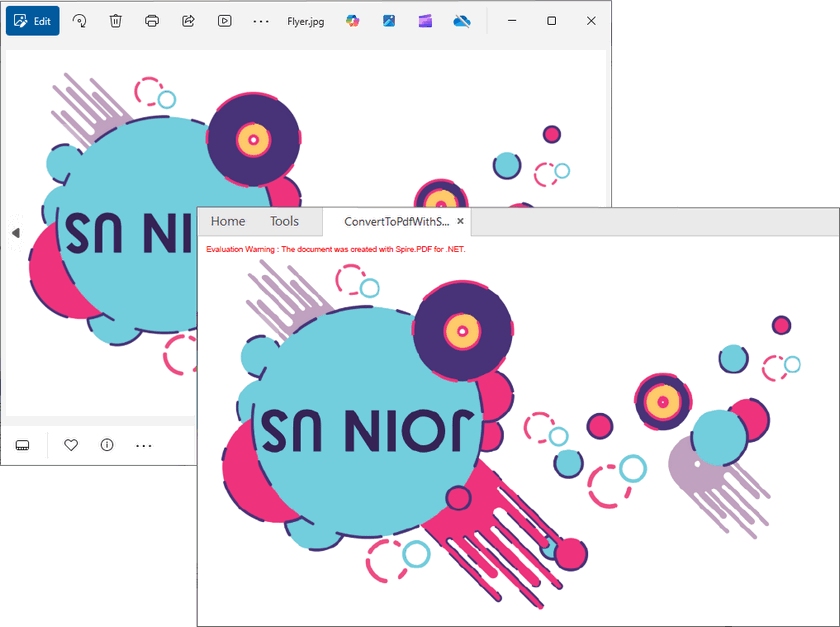
Converting Multiple Images to a Single PDF
If you have multiple images that you want to combine into a single PDF document, the process is similar to the single-image conversion, but with a loop to handle each image.
C# code to convert JPG, PNG, TIFF, BMP to PDF:
using Spire.Pdf;
using Spire.Pdf.Graphics;
using System.Drawing;
namespace ConvertMultipleImagesIntoPdf
{
class Program
{
static void Main(string[] args)
{
// Create a PdfDocument object
PdfDocument pdf = new PdfDocument();
// Set the page margins to 0
pdf.PageSettings.SetMargins(0);
// Specify the images to be converted
string[] imagePaths = {"Image-1.png", "Image-2.jpg", "Image-3.bmp", "Image-4.tiff"};
// Iterate through each image
foreach (string path in imagePaths)
{
// Load a particular image
Image image = Image.FromFile(path);
// Get the image width and height
float width = image.PhysicalDimension.Width;
float height = image.PhysicalDimension.Height;
// Add a page that has the same size as the image
PdfPageBase page = pdf.Pages.Add(new SizeF(width, height));
//Create a PdfImage object based on the image
PdfImage pdfImage = PdfImage.FromImage(image);
// Draw image at (0, 0) of the page
page.Canvas.DrawImage(pdfImage, 0, 0, pdfImage.Width, pdfImage.Height);
}
// Save the PDF file
pdf.SaveToFile("CombinaImagesToPdf.pdf");
pdf.Dispose();
}
}
}
This C# code loops through an array of image files in different formats, loads each image, adds it to a new page in the PDF document, and then saves the final PDF with all the images.
Output:
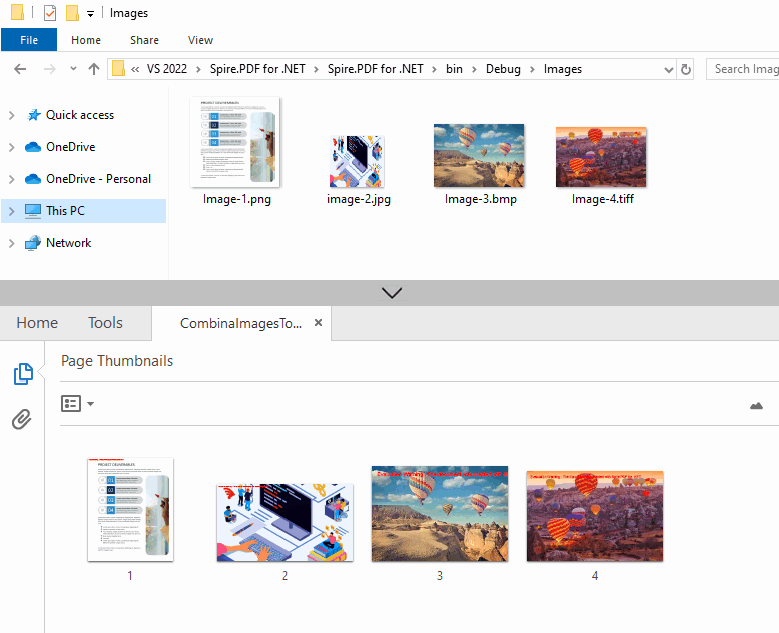
Image to PDF Customization Options
Adjust Page Settings
While conversion, you can customize PDF page properties such as orientation, margins, and size according to the nature of your images:
// Create a PDF document
PdfDocument pdf = new PdfDocument();
// Set page orientation
pdf.PageSettings.Orientation = PdfPageOrientation.Landscape;
// Set page margins (in points, 1 point = 1/72 inch)
pdf.PageSettings.SetMargins(20);
// Set page size
pdf.PageSettings.Size = PdfPageSize.A4;
Resize Images for Optimal Fit
If you need to maintain a fixed PDF page size, you can scale the image to make it fit to page:
// Set fixed page size (e.g., A4)
PdfPageBase page = pdf.Pages.Add(PdfPageSize.A4);
//Load an image
Image image = Image.FromFile("sample.jpg");
// Get the width and heigh of the page
float pageWidth = page.Canvas.ClientSize.Width;
float pageHeight = page.Canvas.ClientSize.Height;
// Scale the image
float scale = Math.Min(pageWidth / image.Width, pageHeight / image.Height);
float scaledWidth = image.Width * scale;
float scaledHeight = image.Height * scale;
// Draw the scaled image on the page
page.Canvas.DrawImage(PdfImage.FromImage(image), 0, 0, scaledWidth, scaledHeight);
FAQs (TIFF to PDF, SVG to PDF)
Q1: What image formats does Spire.PDF support?
A: Spire.PDF seamlessly supports all major image formats:
- JPG/ JPEG
- PNG
- BMP
- TIFF
- GIF
- EMF
- WMF
Ensure your input image is in a supported format for seamless conversion.
Q2: Can I convert a multi-page TIFF image to PDF?
A: Yes! Iterate through TIFF frames to convert. The full code example can be found at: Convert a Multi-Page TIFF Image to a PDF File in C#
Q3: Can I convert SVG image to PDF?
A: Yes! You can load an SVG file with LoadFromSvg() and then save it as a PDF through the SaveToFile(String, FileFormat.PDF) method.
using Spire.Pdf;
namespace SVGtoPDF
{
class Program
{
static void Main(string[] args)
{
// Create a PdfDocument object
PdfDocument doc = new PdfDocument();
// Load a sample SVG file
doc.LoadFromSvg("Sample.svg");
// Save SVG to PDF document
doc.SaveToFile("SVGtoPDF.pdf", FileFormat.PDF);
doc.Dispose();
}
}
}
Q4: Where can I find the VB.NET demos for image to PDF conversion?
A: Spire.PDF fully supports VB.NET. You can convert the C# code samples provided above to VB.NET via code converter tools (e.g. Telerik Code Converter).
Conclusion
With Spire.PDF for .NET, converting images to PDF in C# becomes simple and flexible. This guide shows you how to:
- Convert a single or multiple images into a PDF document.
- Customize page size, margins, and layout for your PDF output.
By following the examples in this guide, you can seamlessly integrate image-to-PDF conversion into your .NET applications.
For advanced features (encryption, annotation), explore Spire.PDF’s online documentation.
Get a Free License
Need to remove watermarks on output files and get rid of restrictions? You can request a 30-day full-featured trial license. A tutorial on how to use the license file is available here.
A text file is a type of computer file that contains plain text. It can be viewed on almost any computer but has very basic and limited functionalities. If you would like to perform more manipulations on text files, such as inserting annotations or form fields, you can convert them to PDF. In this article, we will demonstrate how to convert text files to PDF in C# and VB.NET using Spire.PDF for .NET.
Install Spire.PDF for .NET
To begin with, you need to add the DLL files included in the Spire.PDF for.NET package as references in your .NET project. The DLLs files can be either downloaded from this link or installed via NuGet.
PM> Install-Package Spire.PDF
Convert Text Files to PDF in C# and VB.NET
The following are the main steps to convert a text file to PDF using Spire.PDF for .NET:
- Read the text in the text file into a string object using File.ReadAllText() method.
- Create a PdfDocument instance and add a page to the PDF file using PdfDocument.Pages.Add() method.
- Create a PdfTextWidget instance from the text.
- Draw the text onto the PDF page using PdfTextWidget.Draw() method.
- Save the result file using PdfDocument.SaveToFile() method.
- C#
- VB.NET
using Spire.Pdf;
using Spire.Pdf.Graphics;
using System.Drawing;
using System.IO;
namespace ConvertTextToPdf
{
class Program
{
static void Main(string[] args)
{
//Read the text from the text file
string text = File.ReadAllText(@"Input.txt");
//Create a PdfDocument instance
PdfDocument pdf = new PdfDocument();
//Add a page
PdfPageBase page = pdf.Pages.Add();
//Create a PdfFont instance
PdfFont font = new PdfFont(PdfFontFamily.Helvetica, 11);
//Create a PdfTextLayout instance
PdfTextLayout textLayout = new PdfTextLayout();
textLayout.Break = PdfLayoutBreakType.FitPage;
textLayout.Layout = PdfLayoutType.Paginate;
//Create a PdfStringFormat instance
PdfStringFormat format = new PdfStringFormat();
format.Alignment = PdfTextAlignment.Justify;
format.LineSpacing = 20f;
//Create a PdfTextWidget instance from the text
PdfTextWidget textWidget = new PdfTextWidget(text, font, PdfBrushes.Black);
//Set string format
textWidget.StringFormat = format;
//Draw the text at the specified location of the page
RectangleF bounds = new RectangleF(new PointF(10, 25), page.Canvas.ClientSize);
textWidget.Draw(page, bounds, textLayout);
//Save the result file
pdf.SaveToFile("TextToPdf.pdf", FileFormat.PDF);
}
}
}
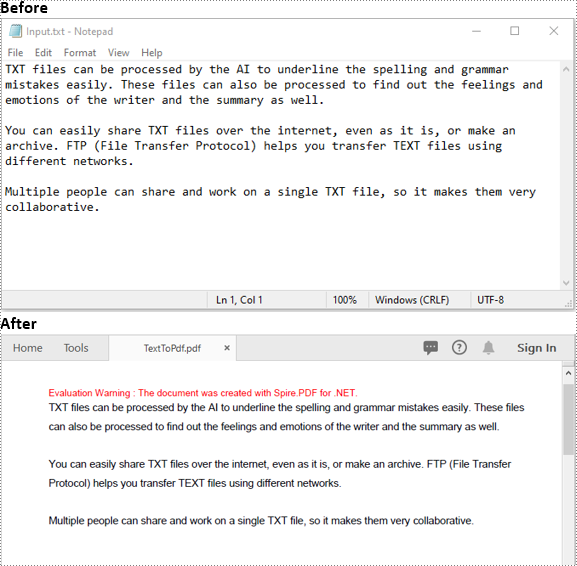
Apply for a Temporary License
If you'd like to remove the evaluation message from the generated documents, or to get rid of the function limitations, please request a 30-day trial license for yourself.

Converting HTML to PDF is a common task for developers who need to generate printable documents or preserve web content offline. With Spire.PDF for .NET, developers can achieve this conversion through multiple approaches that suit different environments. Whether you prefer using the built-in HTML-to-PDF capabilities with the QT plugin, or you want more control through ChromeHtmlConverter, Spire.PDF provides flexible solutions. This tutorial covers several ways to convert HTML to PDF using C# in .NET applications.
| Method | Best For | Features |
|---|---|---|
| 1. Convert HTML/URL to PDF With QT Plugin | Developers who seek quick setup with minimal customization | Login session support; Shorter code with faster conversion process |
| 2. ChromeHtmlConverter with Output Logs | Developers who need high-fidelity output and diagnostics | Pixel-perfect rendering; Executes JS and dynamic content; Logs useful for debugging |
Convert HTML/URL to PDF with QT Plugin
Before guiding you to the specific code sample of how to convert HTML files to PDF format, let me introduce Spire.PDF for .NET to you. It is a powerful C# library designed for creating, editing, and converting PDF documents. Except for HTML to PDF conversion, you can also use it to add digital signatures, create PDF Portfolios, extract elements like texts and images, and PDF file merging and splitting.
More reasons to help you choose Spire.PDF for .NET:
- Compress PDF files from 10 – 100 times to reduce file size
- Widely compatibility of C# environments
- Add encryption to PDF files to protect your file privacy
- More features waiting for you to explore...
To run the conversion process smoothly, you should use the C# API with QT plugin. In the following content, you will learn the step-by-step tutorial.
Step 1. Download Spire.PDF for .NET code library from the official download page to add it in your C# program.
Tip: To unlock all powerful functions of Spire.PDF, please request a 30-day trial license for yourself.
Step 2. Download the plugin on your computer. You can click the following link according to your own computer system.
Step 3. After downloading, unzip package somewhere on your disk to get the "plugins" folder like the pic shows below.

We recommend that you set the "Platform target" of your project to x64 or x86 accordingly.
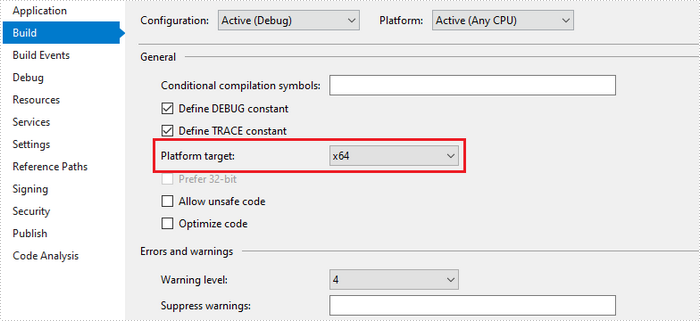
Step 4. After adding the plugin, you just need to copy the following code sample to manage the conversion process.
If you have the original HTML file, copy the following code to your C# program:
using System.IO;
using Spire.Additions.Qt;
using System.Drawing;
using Spire.Pdf.Graphics;
namespace ConvertHtmlStringToPdfWithPlugin
{
class Program
{
static void Main(string[] args)
{
//Get the HTML string from a .html file
string htmlString = File.ReadAllText(@"C:\Users\Administrator\Desktop\Document\Html\Sample.html");
//Specify the output file path
string fileName = "HtmlStringToPdf.pdf";
//Specify the plugin path
string pluginPath = "F:\\Libraries\\Plugin\\plugins-windows-x64\\plugins";
//Set plugin path
HtmlConverter.PluginPath = pluginPath;
//Convert HTML string to PDF
HtmlConverter.Convert(htmlString, fileName, true, 100000, new Size(1080, 1000), new PdfMargins(0), LoadHtmlType.SourceCode);
}
}
}
If you only get the URL, the code sample below is what you need:
using Spire.Pdf.Graphics;
using Spire.Additions.Qt;
using System.Drawing;
namespace ConvertUrlToPdf
{
class Program
{
static void Main(string[] args)
{
//Specify the URL path
string url = "https://www.wikipedia.org/";
//Specify the output file path
string fileName = "UrlToPdf.pdf";
//Specify the plugin path
string pluginPath = "F:\\Libraries\\Plugin\\plugins-windows-x64\\plugins";
//Set the plugin path
HtmlConverter.PluginPath = pluginPath;
//Convert URL to PDF
HtmlConverter.Convert(url, fileName, true, 100000, new Size(1080, 1000), new PdfMargins(0));
}
}
}
RESULT:

Convert HTML to PDF using ChromeHtmlConverter with Output Logs
Unlike standard conversion methods that rely solely on engine defaults or basic libraries, ChromeHtmlConverter leverages the power of a headless Chrome browser to render HTML content exactly as it appears in a real browser environment. It provides output logs, which are essential for diagnosing rendering issues, monitoring conversion performance, or maintaining compliance in production environments.
Let's now look at the specific code to use Spire.PDF for .NET and ChromeHtmlConverter to manage this conversion:
using Spire.Additions.Chrome;
namespace ConvertHtmlToPdfUsingChrome
{
internal class Program
{
static void Main(string[] args)
{
//Specify the input URL and output PDF file path
string inputUrl = @"https://www.e-iceblue.com/Tutorials/Spire.PDF/Spire.PDF-Program-Guide/C-/VB.NET-Convert-Image-to-PDF.html";
string outputFile = @"HtmlToPDF.pdf";
// Specify the log file path
string logFilePath = @"Logs.txt";
//Specify the path to the Chrome plugin
string chromeLocation = @"C:\Program Files\Google\Chrome\Application\chrome.exe";
//Create an instance of the ChromeHtmlConverter class
ChromeHtmlConverter converter = new ChromeHtmlConverter(chromeLocation);
//Enable logging
converter.Logger = new Logger(logFilePath);
//Create an instance of the ConvertOptions class
ConvertOptions options = new ConvertOptions();
//Set conversion timeout
options.Timeout = 10 * 3000;
//Set paper size and page margins of the converted PDF
options.PageSettings = new PageSettings()
{
PaperWidth = 8.27,
PaperHeight = 11.69,
MarginTop = 0,
MarginLeft = 0,
MarginRight = 0,
MarginBottom = 0
};
//Convert the URL to PDF
converter.ConvertToPdf(inputUrl, outputFile, options);
}
}
}
The output log looks like below:
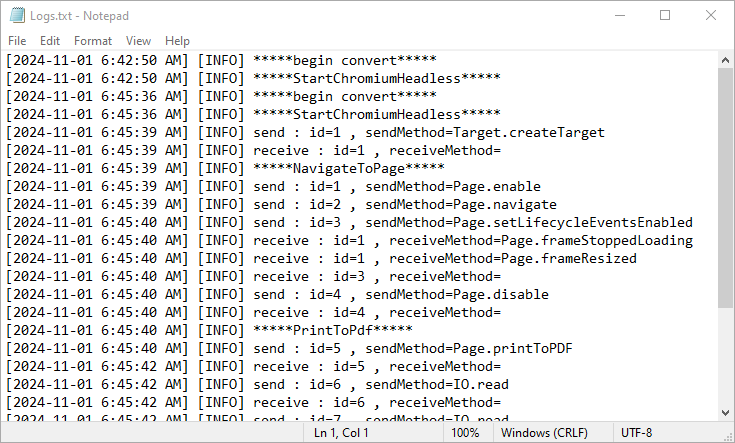
Read more details with the following post:
Convert HTML to PDF using ChromeHtmlConverter
Conclusion:
Spire.PDF for .NET offers a range of tools to convert HTML/URL to PDF in C#, whether you're dealing with local HTML files or remote web pages. Depending on your project requirements—such as rendering complexity, output quality, or dependency preferences, you can select the most suitable method.
